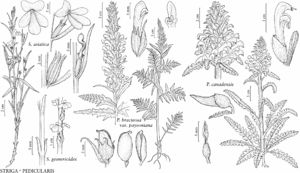Pedicularis canadensis
Mant. Pl. 1: 86. 1767.
Plants 4–50 cm. Leaves: basal 2–20, blade lanceolate, 15–100 x 3–40 mm, 1- or 2-pinnatifid, margins of adjacent lobes nonoverlapping or slightly overlapping distally, 1- or 2-serrate, surfaces glabrous or hispid; cauline 1–10, blade lanceolate, 10–70 x 5–20 mm, 1-pinnatifid, margins of adjacent lobes nonoverlapping or slightly overlapping distally, 1- or 2-serrate, surfaces glabrous or hispid. Racemes simple, 1–5, exceeding basal leaves, each 10–40-flowered; bracts lanceolate, ovate, spatulate, or trullate, 5–40 x 1–10 mm, undivided proximally, undivided to 1-pinnatifid distally, proximal margins entire, distal 1- or 2-serrate, sometimes crenate, surfaces glabrous or hispid to tomentose. Pedicels 1.5–2 mm. Flowers: calyx 7–12 mm, glabrous, hispid, or tomentose, lobes 2, triangular, 0.5–2 mm, apex entire, glabrous or ciliate; corolla 18–25 mm, tube yellow, 8–15 mm; galea yellow, yellow with red veins, or red, sometimes purple, 10–14 mm, beakless, margins entire medially, 1-toothed distally, apex arching over abaxial lip; abaxial lip expanded, yellow or white, 6–7 mm. 2n = 16.
Phenology: Flowering Apr–Jun.
Habitat: Deciduous forests, forest edges, prairies, alpine wet meadows.
Elevation: 70–2500 m.
Distribution
Man., N.B., Ont., Que., Ala., Ark., Colo., Conn., Del., D.C., Fla., Ga., Ill., Ind., Iowa, Kans., Ky., La., Maine, Md., Mass., Mich., Minn., Miss., Mo., Nebr., N.H., N.J., N.Mex., N.Y., N.C., N.Dak., Ohio, Okla., Pa., R.I., S.C., S.Dak., Tenn., Tex., Vt., Va., W.Va., Wis., Mexico.
Discussion
Pedicularis canadensis is chiefly of the Midwestern prairies; in eastern states and provinces, it grows in forest openings and along forest edges. It also inhabits alpine wet meadows at higher elevations along the Front Range of the Rocky Mountains. Corollas may be yellow, yellow with red veins, red (forma praeclara A. H. Moore), or bicolored with a yellow corolla tube, yellow abaxial lip, and red galea (forma bicolor Farwell).
Selected References
None.
